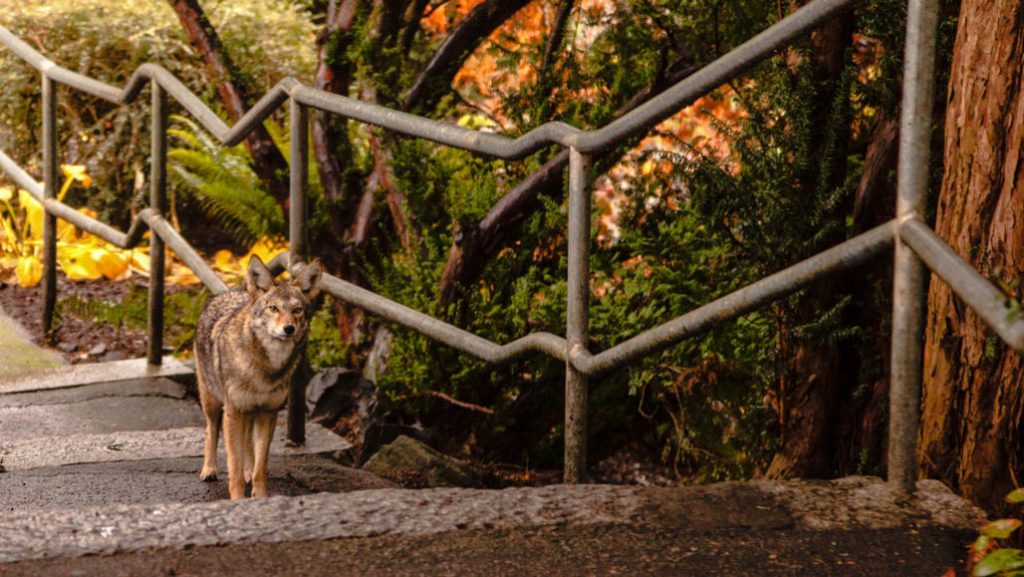5 reasons you might be seeing more wildlife during the COVID-19 pandemic
July 7, 2020
People are spotting more animals, but not because there are more of them

Coyotes sauntering down the streets of San Francisco. Neighborhoods flooded with birdsong. Snakes slithering onto trails and sidewalks. And of course, the rats. Rats everywhere. Somehow, as COVID-19 forced us all into our homes, it also managed to bring nature a little bit closer. Sometimes — as in the case of rats — a little uncomfortably close.
Newspapers have eagerly reported sightings of wildlife in the streets. The U.S. Centers for Disease Control and Prevention even issued guidelines to deal with an expected flood of rats. It’s easy to think that nature is sweeping into our ordered lives and taking over now. But numbers of rats or coyotes probably aren’t all that much higher than normal, and animals aren’t even necessarily going anywhere new. Instead, COVID-19 has changed the way we interact with the natural world.
Here are five reasons that people might be running into more wildlife than before.
1. Human handouts are scarce.
Restaurants are closed, and dumpsters usually filled with trash lie empty. That might be forcing rats out into the open to search for food. People have certainly claimed to see more rats. But there’s not yet real data to back that up, says Jonathan Richardson, an urban ecologist at the University of Richmond in Virginia.
“We would expect them to be impacted as restaurants close and trash generation moves to residential buildings,” he says. “It’s very intuitive, but lots of people are throwing that around without data to support it.” He and his colleagues are in the process of gathering some of that data themselves, using surveys of pest management groups and calls to city services about rats.
Rodents are prone to boom and bust cycles in their populations, as opportunities for food and threats from predators (or pest control) come and go. If food is scarce enough for rats during shutdowns, he says, “it could be the beginning of a bust cycle. A lot of city health folks are hoping that’s the case.”
But if there is a bust, he says, don’t get your hopes up that it will last. “It would absolutely be temporary,” Richardson says. “They’re just so adapted to breeding quickly and reproducing they’ll be able to repopulate declined populations very quickly.”
2. Scary humans aren’t around as much.
Every animal exists in a landscape of fear — trying to get what they need while avoiding areas where predators might be lurking, says ecologist John Laundre. Those predators include humans. “We are predators on pretty much everything,” says Laundre, of Western Oregon University in Monmouth. “Everything fears us.”
Pumas in the Santa Cruz Mountains, for example, will chow down peacefully on a carcass while a nearby speaker plays nature noises. But the big cats beat a speedy retreat when the speaker switches to the sound of humans talking, a 2017 study in the Proceedings of the Royal Society B showed. Similarly, black bears living near human-inhabited areas avoid those areas during the day. They prefer to venture to peopled places at night, when humans are less likely to be out, according to a 2019 study in Movement Ecology.
When humans retreat, due to lockdowns and stay-at-home orders, the landscape of fear that we create retreats with us. Animals common in suburban areas, such as coyotes, might normally restrict their activities to the evening and night. But “the fewer people they see around,” Laundre explains, “the more willing they are to come out during the day.”
3. It’s nice and quiet.
Not all animals fear us. “We can see a lot of birds flying around and coming to our feeders,” Laundre notes. “They know humans are safe.”
Those humans are, in turn, taking greater notice of their avian neighbors in the time of COVID-19. “I would say noise pollution is the biggest reason people notice them,” says Gustavo Bravo, an ornithologist at Harvard University. Or rather, the lack of noise pollution. “If everyone is hunkered down at their homes, cities are quieter,” he notes.
The Sounds of the City project, a New York University study that places microphones around New York City to study urban noise, showed drastic decreases in the sounds of traffic and people as COVID-19 took hold.
“Birds will adjust their song and the times they are singing to account for urban noise,” notes Deja Perkins, an urban ecologist at North Carolina State University in Raleigh. “Usually, they sing earlier in the day to avoid competing with city noises such as traffic.” They also sing at a higher sound frequency in urban neighborhoods to help their songs stand out against the city’s roar (SN: 7/16/03).
While it’s too early to say if birds have changed their singing times or tones in the quieter streets, she says, we are better able to hear them. And people are taking note. The Cornell Lab of Ornithology’s Global Big Day, which invites people to log their bird observations on the eBird app and website once a year, reported a 32 percent increase in participation compared with 2019.
4. Spring has sprung.
If the birds seem especially musical, Bravo explains, it’s because they are. COVID-19 happened to hit the Northern Hemisphere at a critical time. “March, April and May are the spring migration months in the Northern Hemisphere,” he says. “Also for the resident birds not migrating, it’s the time they mate. They sing a lot; they’re looking for their partner.”
Birds aren’t the only animals becoming more common in spring. “This is the time of year – March, April, May — when snakes are coming out of hibernation, to eat, warm up and look for each other to mate,” says David Steen, a herpetologist at the Florida Fish and Wildlife Conservation Commission in Gainesville. It’s nothing to do with COVID-19. “I’ve been answering people’s questions about snakes and identifying snakes for people for a decade or so,” he says. “This is my busy season.”
5. We’re finally paying attention.
But the snakes themselves never changed. “These snakes have always been right next to us,” Steen says. “We’ve been living with these animals [for] so long. We just happen to see them more often [now].”
People who previously might have traveled to wide vistas and tried to spot rare species may be stuck a bit closer to home, and finally paying attention to their back gardens, says Helen Smith, an arachnologist with the British Arachnological Society who’s based in Norfolk, England. “They’re at home more and in their local patch more,” she says. The BAS has put out several surveys to help people report their spider sightings. “You’re living with these really interesting animals,” she says. “Make friends with them.”
Our social media fixation also helps shine a spotlight on local wildlife sightings, Bravo notes. “People have started to post about it on social media, and because everyone was looking at social media, it spread it out fast.” In Bravo’s home country of Colombia, he says, “even some national celebrities were posting pictures of birds. It’s not something they’d do on a daily basis, but they’re sitting at home.”
Perkins, who has been involved with #BlackBirdersWeek, an effort to promote birders of color on Twitter, hopes that the social media and in-person attention will spark interest in local wildlife that extends into the post-COVID-19 world. “I hope that people continue to go outdoors and make these observations and pay attention to the wildlife that we have around us,” Perkins says. “And [that it’s] helping people to notice that people aren’t the only things that thrive in cities.”
Related Articles
आज बुधबार एकैपटक ११४ जनामा कोरोना पुष्टि, नेपालमा संक्रमितको संख्या ८८६ पुग्यो
नेपालमा कोरोना संक्रमितको संख्या ८८६ पुगेको स्वास्थ्य तथा जनसंख्या मन्त्रालयले जनाएको छ । बुधबार थप ११४ जनामा कोरोना संक्रमण पुष्टि भएको मन्त्रालयले जनाएको हो । मन्त्रालयले आयोजना गरेको नियमित मिडिया ब्रिफिङमा प्रवक्ता डा विकास देवकोटाले संक्रमित हुनेमा […]
Trending Articles
New price list of books form class 1 to 12 for BS 2080
Curriculum development center Sanothimi Bhaktapur under the Ministry of Education, Science, and Technology has released the price of new books from class 1 to class 12 for the educational year 2080. The price is only […]
Popular Tags: 7 Days
Upcoming MCQs

Computer Fundamental Multiple Choice Questions Exam Free
- 2022-03-20 12:45
- 60 Mins
- 12 Enrolled
- 25 Full Marks
- 10 Pass Makrs
- 25 Questions











